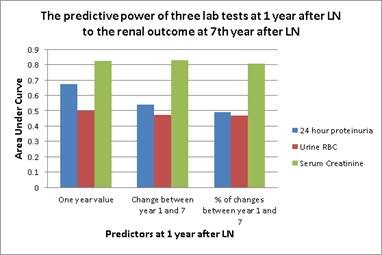Session Information
Date: Tuesday, November 15, 2016
Title: Systemic Lupus Erythematosus – Clinical Aspects and Treatment - Poster III: Biomarkers and Nephritis
Session Type: ACR Poster Session C
Session Time: 9:00AM-11:00AM
Background/Purpose: Lupus nephritis (LN) manifests with proteinuria and/or active urine sediment. Renal composite indices include proteinuria, urinary active sediment (RBCs, casts) and serum creatinine. Complete proteinuria recovery (CR) is defined as <0.5 g/d but it is currently unclear which proteinuria cutoff best predicts good clinical outcomes.
We aimed to determine: a) the predictive ability of proteinuria, urinary sediment (uRBCs) and serum creatinine (Cr) at 1 year to predict good long-term outcomes, and b) the best proteinuria cut-off at 1 year to predict good long-term outcomes.
Methods: This retrospective analysis was performed on prospective data from a single lupus cohort of 1849 patients. Patients with LN (24-hr proteinuria [24H-P] >0.5 g/d) were identified and baseline was defined as the onset of LN. Patients on whom microscopic urine analysis with at least 7 years’ follow-up were studied. Patients with end-stage renal disease (ESRD) or renal transplant/dialysis at baseline were excluded. Good renal outcome was defined as Cr <100 mmol/L and renal transplant/dialysis-free at 7 years.
Receiver operating characteristic (ROC) curves were generated to examine the predictive power of Cr, 24H-P, and uRBCs at 1 year post-LN diagnosis with respect to good renal outcome. Area under curves (AUC) were analyzed for: a) 24H-P at year 1, b) absolute change in 24H-P between year 1 and 7, and c) percent change in 24H-P between year 1 and 7. The proteinuria cutoff was identified by optimizing sensitivity and specificity. Additional sensitivity analyses were conducted for patients with baseline 24H-P of >2.5 g/d, >2.0 g/d, and >1.5 g/d. This analysis was repeated for uRBCs and Cr.
Results: 101 LN patients were analyzed, with baseline 24H-P of 2.36 ± 2.31 g/d. At 7 years Cr was 85.6 ± 40.0 mmol/L. 24H-P of 0.6 g/d at 1 year after LN diagnosis best predicted good long-term renal outcome, with sensitivity 62% and specificity 70% (Fig. 1). In the sensitivity analyses, proteinuria cut-off of 1.0 g/d was identified for groups with baseline 24H-P >2.5 g/d, >2.0 g/d, and >1.5 g/d.
The AUC analysis confirmed that 24H-P at 1 year, but not absolute/percent change, is a predictor of good long-term renal outcomes (Fig. 1, 2). uRBCs did not provide any predictive benefit while Cr at 1 year predicted long-term renal outcome with an AUC of 0.82 (Fig. 2).
Conclusion: Proteinuria of 0.6 g/d at 1 year post-LN diagnosis best predicted good long-term renal outcome. Serum creatinine at 1 year was also a strong predictor of long-term renal outcome, whereas urinary RBCs did not offer any prognostic benefit.
Figure 1. ROC curve for proteinuria at 1 year, absolute change and percentage of change between year 1 and 7
Figure 2. ROC analyses for proteinuria levels, Cr and uRBC at 1 year, absolute change and percentage of change between at year 1 and 7
To cite this abstract in AMA style:
Fung W, Su J, Touma Z. Predictors of Good Long-Term Renal Outcomes in Lupus Nephritis [abstract]. Arthritis Rheumatol. 2016; 68 (suppl 10). https://acrabstracts.org/abstract/predictors-of-good-long-term-renal-outcomes-in-lupus-nephritis/. Accessed .« Back to 2016 ACR/ARHP Annual Meeting
ACR Meeting Abstracts - https://acrabstracts.org/abstract/predictors-of-good-long-term-renal-outcomes-in-lupus-nephritis/


